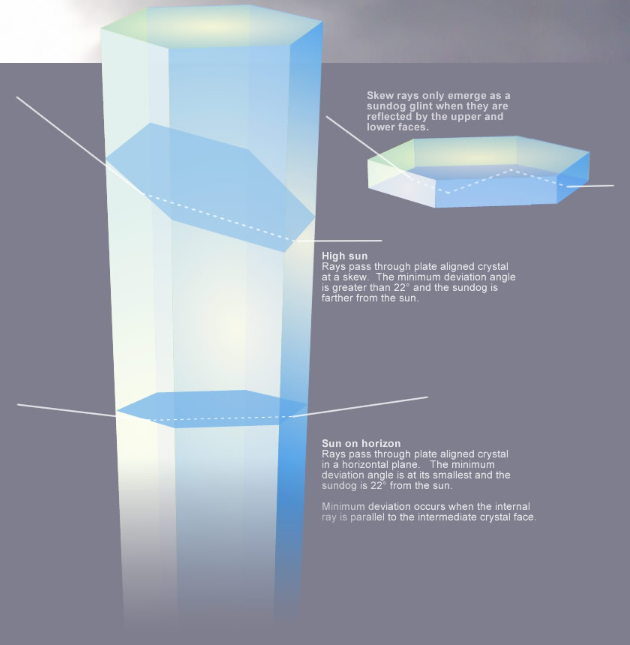OPOD - Halos & Red Arrows
OPOD - Halos & Red Arrows: A Closer Look at Atmospheric Optics
Have you ever gazed up at the sky and noticed fascinating optical phenomena? From halos to sundogs, our atmosphere can create captivating displays of light. In this article, we delve deeper into the intriguing world of atmospheric optics, specifically focusing on halos and red arrows.
The Enigmatic Red Arrows and Circumscribed Halos
In a stunning display of precision and skill, the RAF Aerobatic Team, known as the Red Arrows, gracefully trace the curve of a circumscribed halo. This mesmerizing sight showcases the intricate relationship between atmospheric optics and aerobatic maneuvers.
Challenging Preconceptions: Sundogs and the Circumscribed Halo
Contrary to popular belief, sundogs are not always positioned 22° from the sun. An interesting observation captured by Mark McCaughrean in Duxford, Cambridgeshire, England, reveals that the right-hand sundog coincides with the circumscribed halo. This discovery challenges the notion that sundogs are consistently located at a fixed angle from the sun.
The Altitude Factor: Sundogs and the Sun's Position
The position of the sun in the sky plays a crucial role in determining the distance between sundogs and the sun. When the sun is near the horizon, sundogs appear at a distance of 22° from the sun. However, as the sun ascends higher in the sky, sundogs progressively move farther away from its position.
Unraveling the Sundog Phenomenon
Sundogs, also known as parhelia, are a result of a fascinating optical effect called minimum deviation. This effect occurs when rays of light enter a horizontal plate crystal through one side face and exit through another side face inclined at a 60° angle. The rays undergo deflection, with some reaching the minimum deviation condition, where the ray crossing the crystal is parallel to the intermediate side face. This alignment leads to the brightest portion of the sundog.
The Intricacies of Minimum Deviation
At sunrise or sunset, when the sun is at the horizon, the minimum deviation angle for sundogs is 22°. Rays of light cross the crystal in a horizontal plane, contributing to the distinctive appearance of sundogs at this specific angle. However, as the sun rises higher in the sky, the angles of incidence and exit become larger, resulting in a correspondingly greater minimum deviation angle for sundogs.
Reflections and Skewed Planes: The Formation of Sundogs
When the sun is moderately high in the sky, rays of light passing through crystal plates in a skewed fashion undergo multiple reflections from the upper and lower horizontal faces. These reflections cause the rays to emerge at various angles, ultimately forming the characteristic shape of a sundog. The intricate interplay between light and ice crystals creates a captivating visual phenomenon.
In conclusion, atmospheric optics never fails to astound us with its intricate displays of light. From the elegant curves traced by the Red Arrows within circumscribed halos to the shifting positions of sundogs based on the sun's altitude, these phenomena offer a glimpse into the fascinating world above us. Next time you find yourself beneath a clear sky, take a moment to observe and appreciate the wonders of atmospheric optics.

Red Arrows & Halos
The RAF Aerobatic Team echo the curve of a circumscribed halo.
The right hand sundog interestingly coincides with the circumscribed halo disproving that sundogs are always 22° from the sun.
Imaged at Duxford, Cambridgeshire, England by Mark McCaughrean. ©Mark McCaughrean, shown with permission

The sun was ~42° high and at that altitude the "22° parhelia" sit concidentally at where the circumscribed halo crosses the parhelic circle. The inner halo is the 22° radius halo. Sundogs move further and further from the sun as it increases in altitude. Sundogs are only 22° distant when the sun is on the horizon.
Sundogs are a minimum deviation effect. Rays enter the side face of a horizontal plate crystal and leave through another side face inclined 60° to the first. Rays can be deflected through a variety of angles but not less than the minimum one that occurs when the ray crossing the crystal is parallel to the intermediate side face. Many rays bunch at the minimum deviation condition and these produce the brightest part of the sundog.
The minimum deviation angle is 22° when the sun is at the horizon and rays cross the crystal in a horizontal plane.
Rays from a high sun pass through plate aligned ice crystals in a plane skewed from horizontal. The angles of incidence and exit are larger and the minimum deviation angle is correspondingly greater than 22°. the sundog is farther from the sun.
Rays from a moderately high sun passing through the crystal in this skew fashion are several times reflected from the upper and lower horizontal faces before emerging to form the 'dog'.
Note: this article has been automatically converted from the old site and may not appear as intended. You can find the original article here.
Reference Atmospheric Optics
If you use any of the definitions, information, or data presented on Atmospheric Optics, please copy the link or reference below to properly credit us as the reference source. Thank you!
-
<a href="https://atoptics.co.uk/blog/opod-halos-red-arrows/">OPOD - Halos & Red Arrows</a>
-
"OPOD - Halos & Red Arrows". Atmospheric Optics. Accessed on November 26, 2024. https://atoptics.co.uk/blog/opod-halos-red-arrows/.
-
"OPOD - Halos & Red Arrows". Atmospheric Optics, https://atoptics.co.uk/blog/opod-halos-red-arrows/. Accessed 26 November, 2024
-
OPOD - Halos & Red Arrows. Atmospheric Optics. Retrieved from https://atoptics.co.uk/blog/opod-halos-red-arrows/.